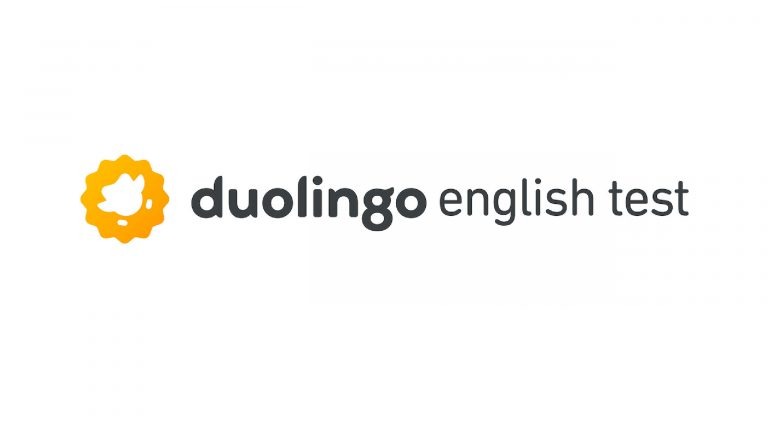
A review of the Duolingo English Test
What is the Duolingo English Test and is it a good option for you as a test-taker? That’s what Nick and I will be discussing in today’s lesson!
If you have ever thought about studying a second language and searched online for an app to help you, then there is a high chance the you have come across Duolingo. It is one of oldest and most-well know language learning apps, and is well-known for being easy to use, especially for beginners. I remember using the app to get to grips with Italian before going on holiday to Tuscany, and I found it was a great way to learn the basics in a fun way.
I was asked to match words with pictures, repeat simple phrases, and make short translations. It was all very intuitive and there were cute pictures and sounds to keep me motivated, and I was rewarded for studying every day. In short, Duolingo seemed to be a simple app designed to help people learn the basics of a language. That is why I was surprised a couple of months ago to find out about the Duolingo English Test. A test that is now accepted at over 1,500 institutes world-wide as an alternative to IELTS and TOEFL.
It seemed mind-blowing to me that the makers of this seemingly smile app had managed to create an academic exam that could accurately predict a student’s ability to perform at university. So, what exactly is the format of the Duolingo English Test? And how easy or difficult is it compared to the other academic exams? Well, we thought the only way to find out was to try the test ourselves! Listen to the episode to find out how we got on!
Below, you can find a summary of the episode, which includes all of the links to useful materials and the times of each part of the discussion (so you can go directly to the part you want to listen to) 🚀
- Subscribe to My IELTS Classroom podcast on Apple podcasts here
- Subscribe to My IELTS Classroom on Google podcasts here
- Become a Patreon to gain access to extra BONUS episodes here

What do you know about Duolingo?
As I said in the introduction, Duolingo is an app that can be downloaded onto your tablet or smartphone to you learn a language. There are currently 37 languages on offer on the app, and over half a billion users!
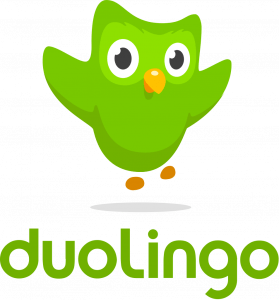
What is the Duolingo English Test
Duolingo has recently developed the Duolingo English Test. This is a new alternative to the IELTS Academic test for students who want to study in an English speaking country. Unlike IELTS, which is accepted by almost every higher learning institute around the world, as of today, the Duolingo English Test is only accepted by 1780 colleges or universties. However, this number is rising and with high-quality universities like Yale, Duke, and John Hopkins adding the test to their admissions criteria, I expect that this number grow sharply in the near future.
As Duolingo is an American company, at the moment most of the institutes that accept the test are either in America or are subsidiaries of American universities. However, again, this is changing. I went through the list of institutes and found that there were representatives from Afghanistan, America, Australia, Bangladesh, Belgium, Brazil, Bulgaria, Canada,Cayman Islands, Chile, China, Colombia, Costa Rica, Cyprus, Czechia, Egypt, El Salvador, France, Germany, Gibraltar, Hong Kong, Ireland, Italy, Japan, Kazakhstan, Latvia, Lebanon, Mexico, Qatar, Romania, Somalia, South Africa, South Korea, Spain, Thailand, United Kingdom, and Uzbekistan.

Just to be 100% clear – the Duolingo English Test this can only currently be used to prove your level of English proficiency to potential education providers.
As of now, the test cannot be used for migration purposes or to prove your level of proficiency to professional bodies.
Duolingo English Test: The basic facts
Let’s start by looking at some basic facts about the exam:
- How and where can I take the Duolingo English Test? The test is available online and can be taken at any time you wish i.e. it is an on-demand test that can be taken at home or work via a computer (there are technical specifications that we will talk about in a moment)
- How long does the Duolingo English Test take? It is short – just under 60 minutes. Plus, your results will be delivered in 48 hours and available to share with an unlimited number of institutes immediately.
- How much does the Duolingo English Test cost? This is the most interesting part to me – it is just $49. That makes it less than a quarter of the price of IELTS and, with an unlimited number of practice questions available online, it is a very cost-effective way to prove your English proficiency.
With all these benefits, I guess the only real question left is what the test consists of, and this is where things get interesting!
What are the components of the Duolingo English Test?
This is where It think things get interesting. Up until now, all tests of English for Academic purposes have been fairly similar. You will be asked to complete structured reading, speaking, listening, and reading tasks that mimic the type of activities you will be required to do as a student. For example, you may be asked to write an essay, or read an extract from an academic journal, or listen to a conversation between two students.
The Duolingo English Test is not like this at all
For a start, there are no listening or reading components at all, with all of the test items being based on vocabulary, grammar, speaking and writing. There also does not seem to be any test at all of basic academic skills as the writing components are all short form and as you to write minimum of either 50 or 100 words, with no specific given asked for (i.e. it never ask you to write an “essay”.) Instead, the tasks other mimic what you are asked to do on the Duolingo App when learning a language (i.e. complete small language puzzles) or to respond naturally to a photo or question.
The other major difference is that the questions in the Duolingo English Test are adaptive. That means that the difficulty of the questions should adapt to the user. Get question after question right, and the level will increase. Get a question wrong and the next may be easier. GMAT is the only other English test that I know of that uses this type of technology, but it is important to know that this is what happening before the test starts, as for strong students it means that there test is likely to be difficult from the start!
Also, as the test is adaptive, there is no rubric. This means that you may have more of one type of question in one test than in another as the adaptive technology tries to assess your level. In any case, you are guaranteed to have to attempt at least one of each question type, so let’s go though them now. As I have never seen these types of questions before, I have given them my own title:
1. Listen and choose the real words (2 minutes)
You will be given 9 short audio files. You will need to listen to a word being spoken and decide if it is a real english word or not. The words are spoken alone, so you have no context to help you.
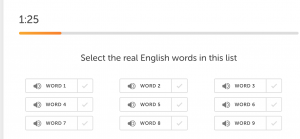
You will have 2 minutes to decide which words are fake and which are real, and you can play the words as many times as you like to help you to decide.
- What is this testing? Obviously, this is a clear test of lexis. My guess is that Duolingo have fed thousands of words into the system that have a clear “level”. Cambridge publishes a corpus of words for each of the CEFR levels, so this would be relatively easy to do. I think that the clever part is the “fake” words, as they do sound real. They use the same suffixes and prefixes as genuine English words, so the pseudo-words are morphologically and phonologically plausible, but have no meaning. I tried to make some myself this morning, and it was not an easy task as my words tended to feel definitely “wrong”!
- Difficulty: If you are a native speaker who is about to enter university or already has a degree, then you should find this relatively easy. However, for second-language learners, this may be a difficult activity as there is no context to decide if the word is real or fake. Plus, with so many words in the English language, how will a student decide if the word is real (but they have no yet learned it) or fake (it does not exist at all)? The answer is they won’t be able to, so the only ogival strategy is just to select the words that you are confident are real.
2. Read and choose the real words (1 minutes)
This is almost identical to the first type of question only now you will read the word instead of listening to it spoken. Again, you will have to determine which are real words and which are fakes.
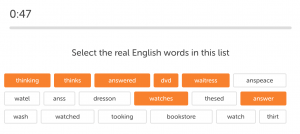
3. Dictation
You will listen to a short spoken statement that will play when you click on an icon. You must write down directly what you hear. You have the option to play the recording up to three times. No indication is given if playing the recording again will lower your score.
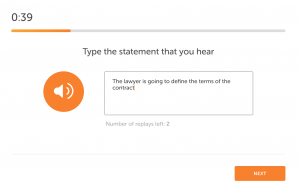
- What is this testing? Honestly, it is hard to know exactly what skill this question is really testing. Obviously you will have to be able to listen and decode the sounds to write the sentence, but from my perspective, there is no guarantee that the student understands the sentence that they have written, so it is hard to say that this is really testing “listening comprehension”. I could, for example, probably completed an exercise like this in Russian very well as I would be able to recognise the sounds, but I may not know what the words mean. The extract is also so short that it is difficult to believe that it provides a meaningful sample of a student’s listening ability. However, my guess is that these fragments have been taken from books and, again, analysed for their difficulty.
- Difficulty: I found that the statements I was asked to listen to were short, clear, and did not include any words that were particularly difficult to spell. For me, this was the easiest of the tasks, but I would like to know if there is a penalty for listening more than once.
If you are looking for the highest level of support and guidance in your IELTS journey, then why not find out about our award-wining Gold Package by clicking here.
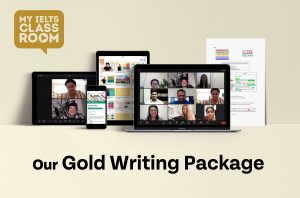
4. Speak a sentence (30 seconds)
Again, this is more or less the reverse of the above task. Now, instead of listening and writing a sentence, you will need to read and speak it. This is the first question that requires you to speak aloud, and hence, why you need a working microphone to take the test.
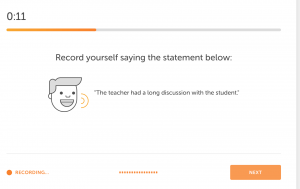
- What is this testing? Reading a simple sentence aloud in English is not a difficult task. I have no idea how the computer will score this task. Is it listening for a particularly type of pronunciation? Will you be given more points for clear diction or more natural intonation? As a test-taker I would like to know this before I sat the exam.
- Difficulty: Just like the dictation task, this was an easy task and probably one designed to discriminate between lower-level students.
5. Complete words in a text (3 minutes)
I have to say that of all the tasks, this was the one that I found the most fun, but also the most challenging. You are given a short paragraph of 2 or 3 sentences, which has words that have been “damaged” i.e. they have missing letters. Your job is to type the missing letters to complete the sentences. You are shown how many letters are missing and there is at least one complete word between each damaged one to help you.
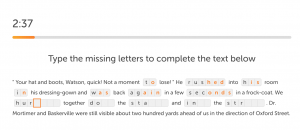
- What is this testing? I found this a fun question type and can see how this is probably testing a number of things at once. First, you will definitely need a good understanding of grammar to be able to predict the type of work that is missing. In the same way, an understanding of collocation is also necessary as the damaged words are often identified through the words surrounding them. In the example above, you may also need to know the idiom “not a minute to lose”, so there is the potential to test many different sentence structures and lexical units here. I like this task.
- Difficulty: I think that this is by far the most challenging of the tasks so far. Even as a native speaker, I struggled with some of the items and even had to leave one word empty. Sadly, with no feedback from the practice tests other than a predicted range of scores at the end, I never found out what it was!
6. Written response to a photo (1 minute)
You are given a picture and asked to write one or more sentences to describe the image. The two images I had featured objects, not people, but it is hard t know if there is a general theme
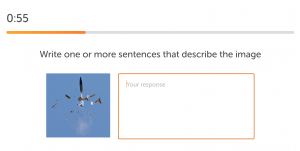
- What is this testing? This is where without having band descriptors like those in IELTS, it is hard to know what the examiners are looking for here. Are you expected to write a literally description of what you see (a rocket with shards of a shattered object around it) or are you supposed to create a story around the image (it looks like a rocket has accidentally smashed into a small plane plane of flying object as it moves upwards into space) I am not sure which would get you higher points, and this is frustrating.
- Difficulty: You only have one minute to respond to the image, so I think that time is the biggest factor here. It is actually quite difficult to analyse the image and then organise what you want to say succinctly in one or two sentences. I think that this item is more difficult than it looks.
7. Written response to a question (Minimum 50 words)
You are given a statement and then asked to give and justify your opinion regarding the information. In my test, I was given one view to agree of disagree with. In Nick’s test, he was given a choice between two options (whether or not a university should develop a research centre for agriculture or business). This suggests that there may be several question types designed to elicit a range of sentence structures.
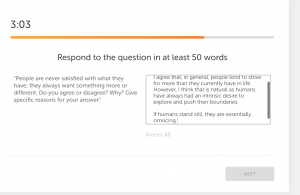
- What is this testing? It looks like this task is testing is students can give and defend a view as both tasks we saw asked you to justify “why” you held your opinion.
- Difficulty: I think that tine is the real factor here. We are told to write a minimum of 50 words, but you are given 5 minutes to do so, which suggests that high-level students should write more. Should we write a full paragraph in favour of our view, or will we get bonus points for considering both options? Is Task Response a factor in scoring, or does the algorithm just look at the language used? I hate not knowing!
8. Written response to a topic (Minimum 3 minutes but up to 5 minutes)
You will be given the choice of two topics to write about for a minimum of three minutes. In my practice test, one of the options was to write about myself and one was to write about a social topic (should parents be held responsible if their children behave badly in school or pubic). There is no word count for this task, but you cannot move forward in the test until at least three minutes have passed. Some topics may ask you to answer multiple questions.
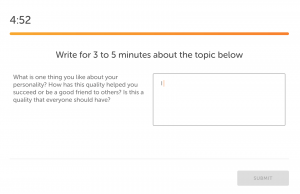
- What is this testing? On the face of it, this task seems very similar to the previous one. In fact, I am struggling to really see the difference. Again, one of the questions asked if I agreed or disagree whereas another asked me to describe. Maybe that i the difference? I am not sure. My guess is that Duolingo may have decided that one sample of writing is not enough to make a meaningful decision about a student’s written ability. However, maybe if I took more tests I would start to see subtle differences in the language produced in the two tasks.
- Difficulty: Again, this will depend on your level, but the fact that one option offers you the chance to talk about yourself may make this easier than the previous task.
9. Spoken response to a question (Minimum 30 seconds but up to 3 minutes)
This tasks looks very much like IELTS Speaking Part 2. You are given a topic that you must talk about for a minimum of 30 seconds. To help you to develop your ideas, you are given four question in bullet points. The topic I was given asked me to talk about a personal experience, which may make it easier than task 10.
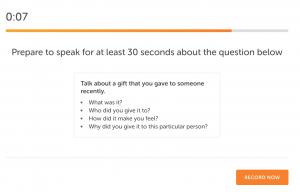
- What is this testing? My guess is that the marking criteria is similar to IELTS so you will be judged on your fluency, grammar, lexis and pronunciation. However, whether these scores are determined by a human marker or an algorithm is not clear.
- Difficulty: As I said above, just like in Speaking Part 2, the topic that you are asked to talk about is personal, so this should make it easier to answer than the second long spoken task.
10.Spoken response to a topic (Minimum 1 minutes but up to 3 minutes)
This is the only section of the test where your computer’s camera will be used to record you answering the question (look a the terrible photo below!) This video interview will be sent to an institution along with your proficiency score when you send your results. Why? I am not sure and part of me is a bit skeptical about why this is necessary. On the one hand, you could argue that institutes want to get a feel for a student and see for themselves what they are capable of. However, I worry that this may result in some forms of discrimination, with other factors such as age, race or sex being taken into account instead of just raw scores.
In any case, in this section you will again have to talk about a given subject for up to 5 minutes. Again, you are given a choice of two questions and, in my test, one was personal and one was asking me to consider a social trend.
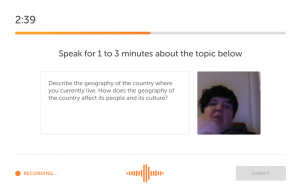
- What is this testing? Again, I am sure that all standard factors of spoken English will be taken into account here (fluency, pronunciation, etc) but you may also be judged on how well you come across on screen, so try to make sure you are well-lit (have a light standing behaving your computer screen) and brush your hair!
- Difficulty: I don’t think that this task was more difficult than the previous one, but you may find it off-putting having to look at yourself on the screen while you talk, especially as you are not allowed to look away from the screen too often during the test!
Duolingo English Test – The final Verdict
I enjoyed taking the test, but as a teacher I have a lot of questions that are still unanswered. These are mostly because there is no guidance given about what type of language each type of question is targeting and how a test-takers’ answers will be marked. From a teaching perspective, this would make it difficult for me to prepare a student well for the Duolingo English Test.
Also, although there are “unlimited practice activities” online (you can find them at https://englishtest.duolingo.com/), you are never shown the answers to the tasks, so it is hard to know if you are doing well or not. Yes, you are given a rough score at the end, but mine was between 110 and 160, which is the equivalent to saying that I am between B2 and C2, and that is a HUGE difference!
This may mean that students are essentially sitting the real test “blind”. However, for $49 and with test results available in 48 hours, I can see why the test is growing so quickly. That really is great value, and for people who have excellent language skills, this may be a test that they can take with no real preparation.
However, or that reason, unlike IELTS or TEOFL, studying for the Duolingo English Test will not arm you with any of the academic skills that are going to need to succeed at university. I would say that investing time in learning how to write the basic English essays or how to deal with long academic texts may feel more difficult, but the skills you learn will be of great use once you start your degree course.
All in all, the Duolingo English Test is definitely offering a new product that is unlike any other English proficiency test. It’s price, and the speed of delivery will make it an attractive option for some students, but the lack of information about the content of the exam will make it a hard one for teachers to prepare them well.
